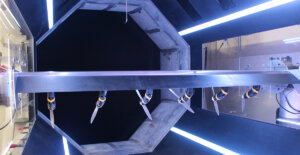
Assistant Professor Ivan Bermejo-Moreno. Photo courtesy of USC Viterbi
In 1947, Chuck Yeager strapped himself into a rocket-powered airplane and flew faster than the speed of sound, becoming the first person to “break the sound barrier.” Just 20 years later, William J. Knight set a world record flight speed of Mach 6.72, or 6.72 times faster than the speed of sound, which remains unchallenged to this day for manned airplanes.
Unsurprisingly, traveling at supersonic (Mach greater than 1) or hypersonic (Mach 5 or greater) speeds takes a large toll on an aircraft’s engine. By using the fast airflow to induce combustion and propel the plane, damaging vibrations are created within the engine.
Ivan Bermejo-Moreno, assistant professor in the Department of Aerospace and Mechanical Engineering, has been developing computer simulations of airflow within a supersonic combustion engine, known as a scramjet, to enhance its lifespan and structural stability.
“This research can impact the future of aerospace transportation,” Bermejo-Moreno said. “The development of reliable and accurate predictive capabilities to simulate this type of flow enables us to explore the underlying controlling mechanisms and to optimally design [scramjets] at a reduced cost compared with [physical] experiments.”
This past summer, Bermejo-Moreno participated in a biennial program held by Stanford University’s Center for Turbulence Research (CTR), where researchers from around the world collaborated on a variety of turbulence related projects. During the month-long program, Bermejo-Moreno was one of five attendees invited to give a tutorial presentation. His talk focused on compressible, turbulent flows at high speeds, a topic his collaboration team was studying.
Working with Anne-Marie Schreyer of the Braunschweig University of Technology in Germany, CTR Senior Research Engineer Javier Urzay and CTR post-doctoral fellow Jeonglae Kim, Bermejo-Moreno and his team investigated methods to control hypersonic airflow at the inlet of a scramjet in order to reduce damage to the engine walls.
“At those high speeds, air and other gases can be largely affected by their compressibility and experience departures from our common experience in low-speed flows,” Bermejo-Moreno said.
For example, at these speeds, regions of abrupt changes in air properties, like pressure, can develop. These thin regions, known as shock waves, interact with turbulent airflow occurring along the interior walls of the engine and create vibrations that could compromise the structural integrity.

A computer simulation of the temperature of supersonic air flowing, from left to right, through a scramjet (red is hot, blue is cold). Photo courtesy of Ivan Bermejo-Moreno
By adding micro-ramps, or small protrusions along the engine wall, they could control the interaction between turbulent airflow and shock waves and minimize engine damage.
“Arrays of micro-ramps deployed along the wall to perturb the flow have been previously shown experimentally to reduce the flow separation induced by the shock waves,” Bermejo-Moreno said.
Prior to the summer program, Schreyer performed experiments on a scramjet inlet lined with micro-ramps in a hypersonic wind tunnel. At CTR, Bermejo-Moreno’s team used the results to develop computer simulation software that recreates the experiment.
“We were trying to replicate these experiments with computer simulations,” Bermejo-Moreno said. By doing so, they would be able to, “optimally design the configuration of the arrays of micro-ramps that can minimize flow separation and its adverse effects on engine performance,” he said.
However, developing a computer simulation that accurately recreates the airflow and captures the detailed characteristics of turbulence is not an easy task. Such high-fidelity simulations require a large amount of computational cost in terms of time and memory, more than even the nation’s fastest computers, commonly referred to as supercomputers, can handle.
“This is the tricky part of turbulent flow simulations: if you want to be physically correct, you have to account for not only what you care about, which is the most energetic motions, but also where the energy is dissipated,” Bermejo-Moreno said. “Today’s computational power is not enough to get the full solution to the vast majority of flows if they are turbulent enough for any realistic application.”
Therefore, to be able to perform realistic simulations, they first had to simplify the computer’s work by creating numerical models that represent individual components of airflow. For example, by characterizing eddies, or vortices created by turbulent air, and grouping them based on size, they can more succinctly account for a large portion of calculations, limiting the required computational cost.
“As we wish to investigate interactions of turbulent flows with other physics, more models are needed, developed and incorporated into the simulation framework to account for those physical interactions,” Bermejo-Moreno said. “So, by adding more models, we decrease the computational cost, which allows us to run simulations that are more realistic.”
By incorporating models they were able to perform true-to-life simulations throughout the summer on the large-memory, high performance computers provided by CTR. Going forward, their work provides the foundation for further investigation into complex, high-speed flows.
The results of their study were presented at the American Physical Society (APS) Division of Fluid Dynamics Conference in November and published by CTR in mid-January.
Published on February 9th, 2017
Last updated on May 17th, 2023









